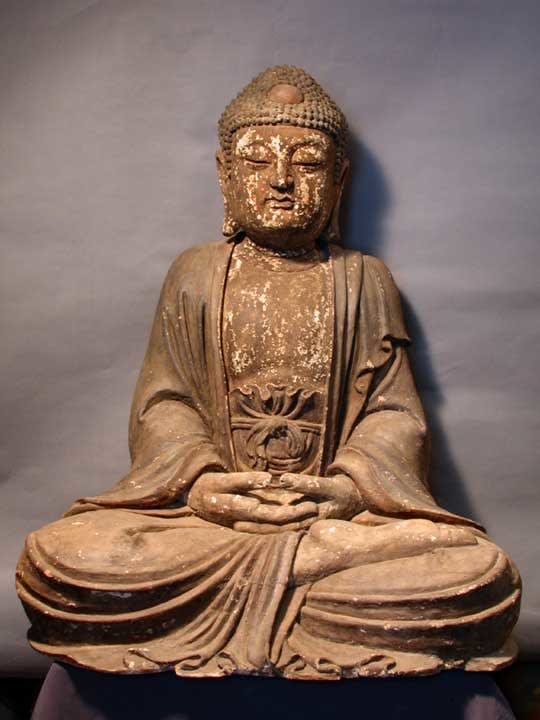Wooden Sculpture of the Vairocana Buddha, 1600 CE - 1750 CE
Lacquered Wood
X.0713 (LSO)
The M’ing dynasty was one of the most important in China’s long history. It saw the toppling of the Y’uan Mongol empire under Hong Wu, the third of only three...
The M’ing dynasty was one of the most important in China’s long history. It saw the toppling of the Y’uan Mongol empire under Hong Wu, the third of only three peasants ever to become emperor in China. The leader of the peasant revolt that ushered in the M’ing dynasty, Hong Wu was an extremely brutal, ruthless dictator, whose creed was one of rabid Neo-Confucianism combined with a militaristic sense of China’s destiny and organisation. The one aspect of Confucius’ learning that he ignored was that declaring military institutions to be inferior to intellectual elites, and that the former should be in the latter’s thrall. A great deal was therefore spent on expanding the army, consolidating defences against attack by the Mongols and neighbouring groups, and in major defensive architecture – notably the Great Wall.
Perhaps reflecting Hong Wu’s own humble origins, the economy came to emphasise agriculture over trade (which Confucianism deemed to be vulgar and parasitical), and provided safeguards for peasants. Negative outcomes included enormous inflation and devaluation of money and resultant social unrest. However, this period also saw enormous cultural strides, including the development of the novel, the introduction of duotone blue/white ceramics and a plethora of artistic and religious developments. The eventual collapse of the M’ing Dynasty was in part triggered by internal dynamics but was primarily induced through the influx of ultra-conservative Manchurian nomads (Manchu) who founded the Q’ing dynasty in 1644. This long-lived dynasty (ending in 1912 with the hapless Pu-Yi) consolidated China’s imperial standing, while cementing the Emperor’s status as a living god and inducing a strong introspective element of Chinese culture that did a great deal to isolate the cultural behemoth from the rest of the world.
The current sculpture dates from this highly changeable and dynamic time. This imposing wooden sculpture depicts the universal (Vairocana) Buddha seated in padmasanam (lotus position) and the hands folded together, palms up, in a meditative position known as dhyana mudra. The Buddha is bare-chested and wears a pantaloon-like garment, tied at the waist with an ornate knot, and overlain with a loose, flowing tunic. He wears a very impassive, reflective and serene expression. The hair is finished in high relief spikelets with the supra-cranial eminence – believed to denote Buddha’s wisdom and learning – marked out clearly in the central aspect of the head. The earlobes are long and pendulous, framing the face in collaboration with the complex hairstyle. The quality of the drapery carving is extremely high, with elegant curves and pleats carefully yet languidly rendered. Traces of lacquered polychrome paint suggest that the figure was originally brightly coloured, although the bare wood is perhaps a better reflection of the Buddha’s placid, wise and wholesome character. The quality and condition of this Buddha are stunning. In terms of aesthetic and social value, this is a truly exceptional specimen that would be the star of any context into which it were placed.
Perhaps reflecting Hong Wu’s own humble origins, the economy came to emphasise agriculture over trade (which Confucianism deemed to be vulgar and parasitical), and provided safeguards for peasants. Negative outcomes included enormous inflation and devaluation of money and resultant social unrest. However, this period also saw enormous cultural strides, including the development of the novel, the introduction of duotone blue/white ceramics and a plethora of artistic and religious developments. The eventual collapse of the M’ing Dynasty was in part triggered by internal dynamics but was primarily induced through the influx of ultra-conservative Manchurian nomads (Manchu) who founded the Q’ing dynasty in 1644. This long-lived dynasty (ending in 1912 with the hapless Pu-Yi) consolidated China’s imperial standing, while cementing the Emperor’s status as a living god and inducing a strong introspective element of Chinese culture that did a great deal to isolate the cultural behemoth from the rest of the world.
The current sculpture dates from this highly changeable and dynamic time. This imposing wooden sculpture depicts the universal (Vairocana) Buddha seated in padmasanam (lotus position) and the hands folded together, palms up, in a meditative position known as dhyana mudra. The Buddha is bare-chested and wears a pantaloon-like garment, tied at the waist with an ornate knot, and overlain with a loose, flowing tunic. He wears a very impassive, reflective and serene expression. The hair is finished in high relief spikelets with the supra-cranial eminence – believed to denote Buddha’s wisdom and learning – marked out clearly in the central aspect of the head. The earlobes are long and pendulous, framing the face in collaboration with the complex hairstyle. The quality of the drapery carving is extremely high, with elegant curves and pleats carefully yet languidly rendered. Traces of lacquered polychrome paint suggest that the figure was originally brightly coloured, although the bare wood is perhaps a better reflection of the Buddha’s placid, wise and wholesome character. The quality and condition of this Buddha are stunning. In terms of aesthetic and social value, this is a truly exceptional specimen that would be the star of any context into which it were placed.



